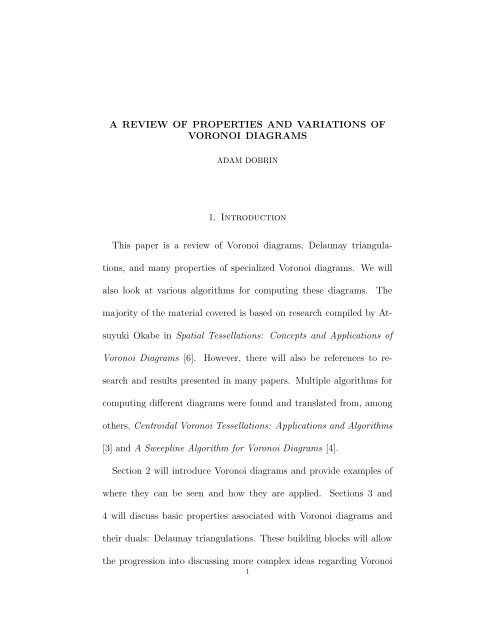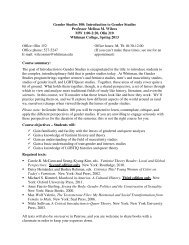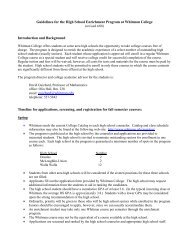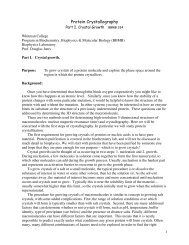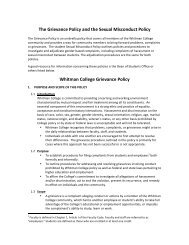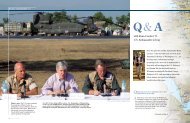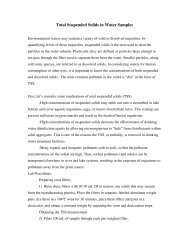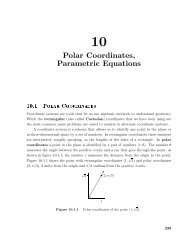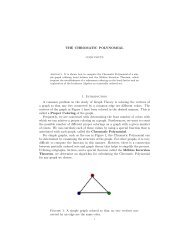A Review of Properties and Variations of Voronoi Diagrams
A Review of Properties and Variations of Voronoi Diagrams
A Review of Properties and Variations of Voronoi Diagrams
Create successful ePaper yourself
Turn your PDF publications into a flip-book with our unique Google optimized e-Paper software.
A REVIEW OF PROPERTIES AND VARIATIONS OFVORONOI DIAGRAMSADAM DOBRIN1. IntroductionThis paper is a review <strong>of</strong> <strong>Voronoi</strong> diagrams, Delaunay triangulations,<strong>and</strong> many properties <strong>of</strong> specialized <strong>Voronoi</strong> diagrams. We willalso look at various algorithms for computing these diagrams.Themajority <strong>of</strong> the material covered is based on research compiled by AtsuyukiOkabe in Spatial Tessellations: Concepts <strong>and</strong> Applications <strong>of</strong><strong>Voronoi</strong> <strong>Diagrams</strong> [6].However, there will also be references to research<strong>and</strong> results presented in many papers. Multiple algorithms forcomputing different diagrams were found <strong>and</strong> translated from, amongothers, Centroidal <strong>Voronoi</strong> Tessellations: Applications <strong>and</strong> Algorithms[3] <strong>and</strong> A Sweepline Algorithm for <strong>Voronoi</strong> <strong>Diagrams</strong> [4].Section 2 will introduce <strong>Voronoi</strong> diagrams <strong>and</strong> provide examples <strong>of</strong>where they can be seen <strong>and</strong> how they are applied.Sections 3 <strong>and</strong>4 will discuss basic properties associated with <strong>Voronoi</strong> diagrams <strong>and</strong>their duals: Delaunay triangulations. These building blocks will allowthe progression into discussing more complex ideas regarding <strong>Voronoi</strong>1
2 ADAM DOBRINdiagrams. In Section 5, there will be an exploration <strong>of</strong> weighted <strong>Voronoi</strong>diagrams, followed by a study <strong>of</strong> different methods for constructing<strong>Voronoi</strong> diagrams in Section 6. The last topic covered, in Section 7,will be the idea <strong>of</strong> centroidal <strong>Voronoi</strong> diagrams <strong>and</strong> different algorithmsfor their construction.2. What is a <strong>Voronoi</strong> Diagram?First, it should be noted that for any positive integer n, there aren-dimensional <strong>Voronoi</strong> diagrams, but this paper will only be dealingwith two-dimensional <strong>Voronoi</strong> diagrams. The <strong>Voronoi</strong> diagram <strong>of</strong> a set<strong>of</strong> “sites” or “generators” (points) is a collection <strong>of</strong> regions that divideup the plane. Each region corresponds to one <strong>of</strong> the sites or generators,<strong>and</strong> all <strong>of</strong> the points in one region are closer to the corresponding sitethan to any other site. Where there is not one closest point, there is aboundary. Note that in Figure 1, the point p is closer to p 1 than to anyother enumerated points. Also note that p ′ , which is on the boundarybetween p 1 <strong>and</strong> p 3 , is equidistant from both <strong>of</strong> those points.As an analogy, imagine a <strong>Voronoi</strong> diagram in R 2 to contain a series<strong>of</strong> isl<strong>and</strong>s (our generator points). Suppose that each <strong>of</strong> these isl<strong>and</strong>shas a boat, with each boat capable <strong>of</strong> going the same speed. Let everypoint in R that can be reached from the boat from isl<strong>and</strong> x before any
A REVIEW OF PROPERTIES AND VARIATIONS OF VORONOI DIAGRAMS 3Figure 1. A basic <strong>Voronoi</strong> diagram [6].other boat be associated with isl<strong>and</strong> x. The region <strong>of</strong> points associatedwith isl<strong>and</strong> x is called a <strong>Voronoi</strong> region.The basic idea <strong>of</strong> <strong>Voronoi</strong> diagrams has many applications in fieldsboth within <strong>and</strong> outside the math world. <strong>Voronoi</strong> diagrams can be usedas both a method <strong>of</strong> solving problems or as a model for examples thatalready exist. They are very useful in computational geometry, particularlyfor representation or quantization problems, <strong>and</strong> are used in thefield <strong>of</strong> robotics for creating a protocol for avoiding detected obstacles.For modeling natural occurrences, they are helpful in the studies <strong>of</strong>plant competition (ecology <strong>and</strong> forestry), territories <strong>of</strong> animals (zoology)<strong>and</strong> neolithic clans <strong>and</strong> tribes (anthropology <strong>and</strong> archaelogy), <strong>and</strong>patterns <strong>of</strong> urban settlements (geography) [2].
4 ADAM DOBRIN3. Basic <strong>Properties</strong> <strong>of</strong> the <strong>Voronoi</strong> Diagram3.1. Formal Definition <strong>of</strong> the <strong>Voronoi</strong> Diagram. We have defineda <strong>Voronoi</strong> diagram informally. Since we are going to be dealing withmathematical problems associated with <strong>and</strong> algorithms for computingthe <strong>Voronoi</strong> diagram, we must formally define the two-dimensional ordinary<strong>Voronoi</strong> diagram.First, we shall denote the location <strong>of</strong> a point p i as (x i1 , x i2 ), <strong>and</strong> thecorresponding vector will be ⃗x. Let P = {p 1 , p 2 , .., p n } ∈ R 2 , where2 ≤ n < ∞ <strong>and</strong> p i ≠ p j , i ≠ j <strong>and</strong> ∀ i, j = 1, 2, . . . , n be the set <strong>of</strong>generator points, or generators. We call the region given byV (p i ) = {⃗x ∣ ∣ ||⃗x − ⃗xi || ≤ ||⃗x − ⃗x j || ∀j ∋ i ≠ j}the <strong>Voronoi</strong> region <strong>of</strong> p i , where || · || is the usual Euclidean distance.V (p i ) may also be referred to as V i . All <strong>Voronoi</strong> regions in an ordinary<strong>Voronoi</strong> are connected <strong>and</strong> convex. We call the set given byV = {V (p 1 ), V (p 2 ), . . . , V (p n )}the <strong>Voronoi</strong> diagram <strong>of</strong> P . Different notation for V is ⋃ ni=1 V i.3.2. Basic Components <strong>of</strong> the <strong>Voronoi</strong> Diagram. The <strong>Voronoi</strong>diagram is composed <strong>of</strong> three elements: generators, edges, <strong>and</strong> vertices.
A REVIEW OF PROPERTIES AND VARIATIONS OF VORONOI DIAGRAMS 5P is the set <strong>of</strong> generators. Every point on the plane that is not a vertexor part <strong>of</strong> an edge is a point in a distinct <strong>Voronoi</strong> region.⋂An edge between the <strong>Voronoi</strong> regions V i <strong>and</strong> V j is V i Vj = e(p i , p j ).If e(p i , p j ) ≠ ∅, V i <strong>and</strong> V jare considered adjacent. Any point ⃗x one(p i , p j ) has the property that ||⃗x − ⃗x i || = ||⃗x − ⃗x j ||. An edge can bedenoted as e i , where i is an index for the edges <strong>and</strong> does not have tobe related to the index <strong>of</strong> generator points. For example, we can labelour edges from 1 to n, n being the total number <strong>of</strong> edges, going topto bottom left to right. The labelling <strong>of</strong> edges is merely a convenience,<strong>and</strong> does not have to follow a pre-determined algorithm. It should bedecided per <strong>Voronoi</strong> diagram.Also, the set <strong>of</strong> edges surrounding a<strong>Voronoi</strong> region V i can be referred to as ∂V (p i ), ∂V i , or the boundary<strong>of</strong> V i .A vertex is located at any point that is equidistant from the three(or more) nearest generator points on the plane. Vertices are denotedq i , <strong>and</strong> are the endpoints <strong>of</strong> edges. The number <strong>of</strong> edges that meet ata vertex is called the degree <strong>of</strong> the vertex. If ∀q i ∈ V, degree(q i ) = 3,then V is considered to be non-degenerate. Otherwise, V is consideredto be degenerate. Throughout this paper, we will, for the most part,assume non-degeneracy in our <strong>Voronoi</strong> diagrams.
6 ADAM DOBRINFigure 2. <strong>Voronoi</strong> <strong>Diagrams</strong> on Bounded Subsets <strong>of</strong> R 2 [6].3.3. <strong>Voronoi</strong> <strong>Diagrams</strong> on a Bounded Subset <strong>of</strong> R 2 . While most<strong>of</strong> the time we will consider <strong>Voronoi</strong> diagrams on R 2 , we can also havethem on any set S ⊆ R 2 .We will assume S to be non-empty, fora <strong>Voronoi</strong> diagram on an empty set would be trivial.The bounded<strong>Voronoi</strong> diagram is defined by V ∩S= {V 1 ∩ S, V 2 ∩ S, . . . , V n ∩ S}.If, for any i, V i shares the boundary <strong>of</strong> S, we call V i ∩ S a boundary<strong>Voronoi</strong> region.Unlike ordinary <strong>Voronoi</strong> regions, boundary <strong>Voronoi</strong>regions need not be connected or convex.In Figure 2, we see two <strong>Voronoi</strong> diagrams generated by the sameset P , but on different subsets <strong>of</strong> R 2 . In the left diagram, the shadedregion is not connected, <strong>and</strong> in both diagrams, many <strong>of</strong> the regions arenot convex. Note that the non-convex regions are boundary regions.3.4. Dominance Regions. Given any two generators, p i <strong>and</strong> p j , theperpendicular bisector <strong>of</strong> the line connecting p i <strong>and</strong> p j is b(p i , p j ) ={⃗x ∣ ∣ ||⃗x − ⃗xi || = ||⃗x − ⃗x j ||}, i ≠ j.H(p i , p j ) = {⃗x ∣ ∣ ||⃗x − ⃗xi || ≤||⃗x − ⃗x j ||}, i ≠ j is the dominance region <strong>of</strong> p i over p j , <strong>and</strong> consists <strong>of</strong>
A REVIEW OF PROPERTIES AND VARIATIONS OF VORONOI DIAGRAMS 7Figure 3. Construction <strong>of</strong> a <strong>Voronoi</strong> Region UsingHalf-Planes [6].every point <strong>of</strong> the plane that is closer to p i than p j or equidistant fromthe two. H(p j , p i ), or Dom(p j , p i ), is the dominance region <strong>of</strong> p j overp i . In the basic <strong>Voronoi</strong> diagram, H(p j , p i ) is a half-plane.From our definition <strong>of</strong> dominance regions, we can define <strong>Voronoi</strong>regions in yet another way.Let P = {p 1 , p 2 , . . . , p n } ∈ R 2 be a set<strong>of</strong> generator points.V i = ⋂ j∈Z + ≤n H(p i, p j ) is the ordinary <strong>Voronoi</strong>region associated with p i . The set V = {V 1 , V 2 , . . . , V n } is the <strong>Voronoi</strong>diagram on R 2 generated by P .In Figure 3, we can see the construction <strong>of</strong> a <strong>Voronoi</strong> region usingdominance regions. By drawing in the half-planes associated with p 1 ,we can see how a <strong>Voronoi</strong> region is created using the method <strong>of</strong> finding⋂j∈Z + ≤n H(p i, p j ). Using this method for all <strong>of</strong> the points in a <strong>Voronoi</strong>
8 ADAM DOBRINFigure 4. A largest empty circle in a basic <strong>Voronoi</strong> diagram[6].diagram becomes overly complicated, <strong>and</strong> is generally bypassed in lieu<strong>of</strong> other algorithms, which will be discussed in Section 6.3.5. The Convex Hull <strong>of</strong> P . The convex hull <strong>of</strong> P is the smallestconvex set containing the generator set P , <strong>and</strong> is denoted as CH(P ).The boundary <strong>of</strong> this region is referred to as ∂ CH(P ). Given a <strong>Voronoi</strong>diagram V(P ), V i is unbounded iff p i ∈ ∂ CH(P ). With knowledge <strong>of</strong>the CH(P ), we know the following about a <strong>Voronoi</strong> diagram V(P ):(i) A <strong>Voronoi</strong> edge e(p i , p j )(≠ ∅) is a line segment iff the line connectingp i <strong>and</strong> p j (p i p j ) is not on ∂ CH(P ).(ii) A <strong>Voronoi</strong> edge e(p i , p j )(≠ ∅) is a half-line or ray iff P is noncollinear<strong>and</strong> p i <strong>and</strong> p j are consecutive generator points on ∂ CH(P ).(iii) All <strong>Voronoi</strong> edges are lines iff P is collinear.3.6. Empty Circles. With a <strong>Voronoi</strong> diagram V(P ), it is helpful toknow about empty circles. An empty circle is one with no generator
A REVIEW OF PROPERTIES AND VARIATIONS OF VORONOI DIAGRAMS 9points within its boundary. For each vertex q i ∈ V(P ), there exists aunique empty circle C i centered at q i that passes through at least threegenerator points, <strong>and</strong> it is the largest empty circle centered at q i . If weassume non-degeneracy, then C i passes through exactly three generatorpoints. Note that the largest empty circle represented in Figure 4 hasthree generator points on its boundary.3.7. Graph Theory <strong>and</strong> <strong>Voronoi</strong> <strong>Diagrams</strong>. Also interesting tonote are the correlations between basic graph theory <strong>and</strong> <strong>Voronoi</strong> diagrams.If we let n, n e , <strong>and</strong> n vbe the number <strong>of</strong> generator points,<strong>Voronoi</strong> edges, <strong>and</strong> <strong>Voronoi</strong> vertices <strong>of</strong> a <strong>Voronoi</strong> diagram, respectively.We find that(1) n v − n e + n = 1.If P has more than 3 elements, thenn e ≤ 3n − 6 <strong>and</strong> n v ≤ 2n − 5Furthermore, if we let n c be the number <strong>of</strong> unbounded <strong>Voronoi</strong> polygons<strong>and</strong> continue to assume that P has more than 3 elements, thenn v ≥ 1 2 (n − n c) + 1 <strong>and</strong> n e ≤ 3n v − n c − 3
A REVIEW OF PROPERTIES AND VARIATIONS OF VORONOI DIAGRAMS11<strong>of</strong> the infinite region. (Note: If we had no unbounded <strong>Voronoi</strong> regionsto begin with, we still have an infinite region not previously defined;thus n c = 1.) Since we have included an extra <strong>Voronoi</strong> region, we’vealtered our equation to be n v − n e + n = 2. Disregard our generatorset P . Our manipulated <strong>Voronoi</strong> diagram V has become a connectedplanar graph G. The number <strong>of</strong> regions n becomes the number <strong>of</strong> facesf in G. The number <strong>of</strong> vertices n v becomes the number <strong>of</strong> vertices v inG. The number <strong>of</strong> edges n e becomes the number <strong>of</strong> edges e in G. Ourequation becomes v − e + f = 2, Euler’s Theorem.4. Delaunay Tessellations4.1. Introduction. Continuing the theme <strong>of</strong> graph theory, we willnow discuss Delaunay tessellations, which are considered to be dualto <strong>Voronoi</strong> diagrams [7]. For all Delaunay tessellations, we will assumenon-collinearity. This means that for our generator set P , the points inP are not all on the same line. Given a <strong>Voronoi</strong> diagram V(P ), join allpairs <strong>of</strong> generator points whose <strong>Voronoi</strong> regions share an edge. Thus,in the Delaunay tessellation <strong>of</strong> P , or D(P ), there exists the edge p i p jif <strong>and</strong> only if e(p i , p j ) ∈ V(P ) ≠ ∅. If this tessellation consists <strong>of</strong> onlytriangles, we call it a Delaunay triangulation. If not, we call it a Delaunaypretriangulation. A Delaunay tessellation will be a triangulation if
12 ADAM DOBRINFigure 6. A <strong>Voronoi</strong> diagram <strong>and</strong> a Delaunay triangulation[6].<strong>and</strong> only if all vertices <strong>of</strong> V(P ) are non-degenerate. See Figure 6 for anillustration <strong>of</strong> the relation between a <strong>Voronoi</strong> diagram (dashed lines)<strong>and</strong> a Delaunay triangulation (solid lines) <strong>of</strong> the same generator set P(solid dots).In a Delaunay triangulation, regions are called Delaunay triangles.Edges in Delaunay tessellations are called Delaunay edges. If a Delaunayedge is shared by two Delaunay triangles, then we call it an internalDelaunay edge. Otherwise, we call it an external Delaunay edge. Theexternal Delaunay edges in D(P ) constitute ∂ CH(P ).Interesting to note is the fact that (assuming non-degeneracy), <strong>Voronoi</strong>edges <strong>and</strong> Delaunay edges are orthogonal. With a little thought, thisis fairly obvious, because a <strong>Voronoi</strong> edge e(p i , p j ) lies on the perpendicularbisector <strong>of</strong> p i p j , a Delaunay edge.This means that <strong>Voronoi</strong>diagrams <strong>and</strong> their Delaunay tessellations are not only dual graphs,but are reciprocal figures [7].
A REVIEW OF PROPERTIES AND VARIATIONS OF VORONOI DIAGRAMS13Figure 7. Delaunay triangulations: (a) is not a Pittewaytriangulation, while (b) is a Pitteway triangulation[6].4.2. The Pitteway Triangulation. The Delaunay triangulation <strong>of</strong> Pis a Pitteway triangulation <strong>of</strong> P if <strong>and</strong> only if every internal Delaunayedge p i p j crosses the associated <strong>Voronoi</strong> edge e(p i , p j ) <strong>of</strong> V(P ).4.3. Correspondence Between <strong>Voronoi</strong> <strong>and</strong> Delaunay. We mentionedthat Delaunay triangulations are non-degenerate duals to <strong>Voronoi</strong>diagrams, but have not yet discussed the meaning <strong>and</strong> results <strong>of</strong> thisclaim. Given a non-degenerate <strong>Voronoi</strong> diagram V(P ) <strong>and</strong> a Delaunaytriangulation D(P ), let Q <strong>and</strong> Q d be the sets <strong>of</strong> <strong>Voronoi</strong> vertices <strong>and</strong>Delaunay vertices, respectively. Let E <strong>and</strong> E d be the sets <strong>of</strong> <strong>Voronoi</strong>edges <strong>and</strong> Delaunay edges, respectively. Let C d be the set <strong>of</strong> circumcenters<strong>of</strong> Delaunay triangles. Then the following are true:(i) Q d = P(ii) C d = Q
14 ADAM DOBRINFigure 8. Empty circumcircles <strong>of</strong> Delaunay triangles(i.e. Delaunay circles) in a Delaunay triangulation [6].(iii)|E d | = |E|Statement (i) says that each generator point p i is a vertex <strong>of</strong> a Delaunaytriangle. Statement (ii) says that the circumcenter <strong>of</strong> each Delaunaytriangle corresponds to a <strong>Voronoi</strong> vertex. Statement (iii) says that thenumber <strong>of</strong> Delaunay edges is equal to the number <strong>of</strong> <strong>Voronoi</strong> edges.On a side note, the circumcenter <strong>of</strong> a Delaunay triangle, is the pointequidistant from the three vertices. It is the center <strong>of</strong> the circumcircle,or Delaunay circle, which is the largest empty circle contained in aDelaunay triangle.The circumcircle <strong>of</strong> the Delaunay triangle is anempty circle only if the triangulation <strong>of</strong> P is a Delaunay triangulation.The points on a Delaunay circle, which are Delaunay vertices, are callednatural neighbors. Two vertices are natural neighbors if <strong>and</strong> only if theyare connected by a Delaunay edge.
A REVIEW OF PROPERTIES AND VARIATIONS OF VORONOI DIAGRAMS15To close, we will look at another interesting property <strong>of</strong> Delaunaytriangulations. Let D(p i , p j ) be the shortest path along the Delaunayedges <strong>of</strong> D(P ) from p i to p j . Then D(p i , p j ) ≤ c ∗ d(p i , p j ), whered(p i , p j ) is the Euclidean distance from p i to p j <strong>and</strong> c =2π ≈ 2.42.3cos( π 6 )5. The Weighted <strong>Voronoi</strong> Diagram5.1. Introduction. So far, in our discussion <strong>of</strong> <strong>Voronoi</strong> diagrams, wehave assumed that our generator points, besides their location, haveequal value, or weight. The idea <strong>of</strong> assigning distinct weight to generatorpoints can be more useful than having uniformly weighted points insome scenarios. Weighted generator points are sometimes more applicablewhen looking at, for example, the population size <strong>of</strong> a settlement,the number <strong>of</strong> stores in a shopping center, or the size <strong>of</strong> an atom in acrystal structure [6].Recall from our definition <strong>of</strong> the <strong>Voronoi</strong> diagram from Section 3.4.that a <strong>Voronoi</strong> region V i is the intersection <strong>of</strong> the dominance regions <strong>of</strong>p i over every other generator point in P . While we will have differentformulae for dominance regions in weighted voronoi diagrams, the idearemains the same. The dominance region <strong>of</strong> a generator point p i overanother, p j , where i ≠ j <strong>and</strong> d w (p x , p y ) is the weighted distance between
16 ADAM DOBRINpoints x <strong>and</strong> y, is written asDom w (p i , p j ) = {p|d w (p, p i ) ≤ d w (p, p j )}.LetV w (p i ) =⋂Dom w (p i , p j ).p j ∈P \{p i }V w (p i ), or V w (i), is called a weighted <strong>Voronoi</strong> region, <strong>and</strong>V w = {V w (p 1 ), V w (p 2 ), . . . , V w (p n )} is called the weighted <strong>Voronoi</strong> diagram.Another way to denote V w is V(P, d w ), where P is the generatorset with weights W = {W 1 , W 2 , . . . , W n } <strong>and</strong> d w is the weighted distance.We will discuss d w more in depth in the following sections.5.2. The Multiplicatively Weighted <strong>Voronoi</strong> Diagram. Recallthe analogy <strong>of</strong> generator points to isl<strong>and</strong>s with boats from Section 2.The multiplicatively-weighted <strong>Voronoi</strong> diagram assigns a speed to eachboat. Therefore, a faster boat will reach boats previously outside <strong>of</strong> itsregion.This weighted <strong>Voronoi</strong> diagram has its weighted distance given byd mw (p, p i ) = ||⃗x − ⃗x i||w i, where w i > 0.This is called the multiplicatively weighted distance or MW-distance.There are many names for the associated <strong>Voronoi</strong> diagram: V mw , the
A REVIEW OF PROPERTIES AND VARIATIONS OF VORONOI DIAGRAMS17multiplicatively-weighted <strong>Voronoi</strong> diagram, the MW-<strong>Voronoi</strong> diagram,the circular Dirichlet tessellation, or the Apollonius model. We willnot be using the last two, as they are highly specialized <strong>and</strong> this paperis a more general survey <strong>of</strong> ideas <strong>and</strong> concepts associated with <strong>Voronoi</strong>diagrams.A MW-<strong>Voronoi</strong> region is a non-empty set, it does not have to beconvex or connected, <strong>and</strong> it can have a hole or holes. A MW-<strong>Voronoi</strong>region V w (p i ) is convex if <strong>and</strong> only if the weights <strong>of</strong> adjacent MW-<strong>Voronoi</strong> regions are not smaller than the weight <strong>of</strong> p i . Another wayto denote “the weight <strong>of</strong> p i ” is w i .Also, two MW-<strong>Voronoi</strong> regionsmay share disconnected edges. Edges in V mw are circular arcs if <strong>and</strong>if only if the weights <strong>of</strong> the two affective regions are not equal. Edgesin V mw are straight lines if <strong>and</strong> only if the weights <strong>of</strong> the two affectiveregions are equal. See Figure 9 for a diagram <strong>of</strong> the bisectors betweenpoints p i <strong>and</strong> p j with multiplicatively weighted distance for severalratios α = w iw j= 1, 2, 3, 4, 5.Let w max = max{w j , p j ∈ P } <strong>and</strong> P max = {p j |w j = w max }. A MW-<strong>Voronoi</strong> region V mw (p i ) is unbounded if <strong>and</strong> only if p i ∈ P max <strong>and</strong> p i ison ∂ CH(P max ).5.3. The Additively Weighted <strong>Voronoi</strong> Diagram. Continuing theboat/isl<strong>and</strong> analogy, imagine that boats in the additively weighted
18 ADAM DOBRINFigure 9. Multiplicatively weighted <strong>Voronoi</strong> diagramsfor two generator points [6].Figure 10. A multiplicately weighted <strong>Voronoi</strong> diagram(the numbers in parentheses represent weights associatedwith the generators) [6].
A REVIEW OF PROPERTIES AND VARIATIONS OF VORONOI DIAGRAMS19<strong>Voronoi</strong> diagram start a certain distance away from their respectiveisl<strong>and</strong>s. They all still travel at the same speed, but some boats begincloser to points than they would in the ordinary <strong>Voronoi</strong> diagram.This type <strong>of</strong> weighted <strong>Voronoi</strong> diagram has its weighted distancegiven byd aw (p, p i ) = ||⃗x − ⃗x i || − w i .The dominance region <strong>of</strong> the additively-weighted <strong>Voronoi</strong> diagram isgiven byDom aw (p i , p j ) = {⃗x ∣ ∣ ||⃗x − ⃗xi || − ||⃗x − ⃗x j || ≤ w i − w j }, where i ≠ j.If we let α = ||⃗x i − ⃗x j ||, <strong>and</strong> β = w i − w j , we get the followingresults. If α = β, then the dominance region <strong>of</strong> p j over p i is a half-lineradiating from p j directly away from p i . This result is impossible withthe multiplicatively-weighted <strong>Voronoi</strong> diagram. If 0 < α < β, then p icompletely dominates p j , <strong>and</strong> V aw (p j ) = ∅, another result not possiblewith MW-<strong>Voronoi</strong> diagrams.With these properties in mind, we find the following statements tobe true. The set V aw (p i ) = ∅ if <strong>and</strong> only ifmin{||x − x i || − w j , ∀p j ∈ P ∋ i ≠ j} < −w i .
20 ADAM DOBRINFigure 11. Additively weighted <strong>Voronoi</strong> diagrams fortwo generator points [6].The set V aw (p i ) is a half-line if <strong>and</strong> only ifmin{||x − x i || − w j , ∀p j ∈ P ∋ i ≠ j} = −w i .The set V aw (p i ) has positive area if <strong>and</strong> only ifmin{||x − x i || − w j , ∀p j ∈ P ∋ i ≠ j} > −w i .Every edge in V aw is either a hyperbolic arc, line segment, half-line,or infinite line. See Figure 11 for a diagram <strong>of</strong> the bisectors betweenpoints p i <strong>and</strong> p j with additively weighted distance for several parametervalues α = ||⃗x i −⃗x j || <strong>and</strong> β = |w i −w j | = 0, 1, 2, 3, 4, 5, 6, 8, 9, 9.8, 10.
A REVIEW OF PROPERTIES AND VARIATIONS OF VORONOI DIAGRAMS21Figure 12. An additively weighted <strong>Voronoi</strong> diagram(the numbers indicate weights) [6].If at least one weight, w i , is different from another, <strong>and</strong> V aw (p i )has positive area, then there exists at least one non-convex additivelyweighted<strong>Voronoi</strong> region. Every non-convex AW-<strong>Voronoi</strong> region is starshapedwith respect to its generator point. This means that from p i ,we can draw a line to any point in the region V aw (p i ), <strong>and</strong> the line willbe contained entirely within V aw (p i ).6. Algorithms for Constructing the <strong>Voronoi</strong> Diagram6.1. Introduction. There are many different ways to construct theordinary <strong>Voronoi</strong> diagram (defined by d w = ||⃗x − ⃗x i ||, i ≠ j). In thissection, we will look at two <strong>of</strong> these: the Plane-Sweep <strong>and</strong> the TreeExpansion <strong>and</strong> Deletion methods.6.2. Plane-Sweep Method. For the plane-sweep method <strong>of</strong> constructingthe <strong>Voronoi</strong> diagram, we draw all generator points, <strong>Voronoi</strong> vertices,
22 ADAM DOBRIN<strong>and</strong> <strong>Voronoi</strong> edges in a non-Cartesian plane. There is a one-to-one correspondencebetween the non-Cartesian plane <strong>and</strong> the Cartesian plane,given some initial assumptions. Therefore, we can copy our <strong>Voronoi</strong> diagramin the non-Cartesian plane to the <strong>Voronoi</strong> diagram in the Cartesianplane, which is what we ultimately want.Let P = {p 1 , p 2 , . . . , p n } be our generator set. For any point p, wedefine r(p) = min{d(p, p i ) ∣ 1 ≤ i ≤ n}. By the properties <strong>of</strong> <strong>Voronoi</strong>diagrams, r(p) is the radius <strong>of</strong> the largest empty circle centered at p.We shall denote the location <strong>of</strong> p as (x(p), y(p)). Letφ(p) = (x(p) + r(p), y(p)).In other words, for any point p ∈ V i , φ(p) = (x(p) + d(p, p i ), y(p)).φ(p) = p if <strong>and</strong> only if p is a generator point. Any q ∈ V, e ∈ V,V i ∈ V, <strong>and</strong> V have images φ(q), φ(e), φ(V i ), <strong>and</strong> φ(V), respectively.Let p i <strong>and</strong> p j be two generator points such that x(p i ) > x(p j ) wheree(p i , p j ) ≠ ∅.φ maps e(p i , p j ) to part <strong>of</strong> a hyperbola with leftmostpoint p i . We will cut this hyperbola at p i into h + (p i , p j ) <strong>and</strong> h − (p i , p j ).h + (p i , p j ) = h + (p j , p i ) <strong>and</strong> h − (p i , p j ) = h − (p j , p i ).To help the reader better underst<strong>and</strong> φ(R 2 ), we can draw an analogybetween it <strong>and</strong> R 2 . Recall the boat/isl<strong>and</strong> analogy from before. Imaginethat there is a current, moving directly to the right, that is faster
A REVIEW OF PROPERTIES AND VARIATIONS OF VORONOI DIAGRAMS23than the uniform-velocity abled boats. Therefore, no boat can reach apoint to the left <strong>of</strong> its isl<strong>and</strong>. <strong>Voronoi</strong> regions in φ(R 2 ) are containedwithin open-right hyperbolas.For the plane-sweep method, we will need to make four initial assumptions.First, numerical computation will be carried out in precisearithmetic. Second, no four generator points align on a common circle.This is the same as assuming non-degeneracy. Third, no two generatorpoints align vertically. Lastly, any generator point <strong>and</strong> any <strong>of</strong> thatgenerator point’s <strong>Voronoi</strong> vertices do not align horizontally.In this method, we take a vertical line <strong>and</strong> move it from left to rightover the plane. We update our data everytime there is an event, whichwill be defined as::the sweepline hits a generator point.:the sweepline hits a <strong>Voronoi</strong> vertex in φ(V).To represent the structure <strong>of</strong> φ(V) along the sweepline, we will usean alternating list L <strong>of</strong> regions <strong>and</strong> boundary edges which appear onthe line, from bottom to top. We will also use Q, a set <strong>of</strong> points inthe plane. It is a list <strong>of</strong> all possible points where events may occur.To begin with, Q = P , the set <strong>of</strong> all generator points. C<strong>and</strong>idates for<strong>Voronoi</strong> vertices φ(q) are added to Q as they are found by the sweepline.
24 ADAM DOBRINFigure 13. <strong>Voronoi</strong> diagram <strong>and</strong> its image: (a) <strong>Voronoi</strong>diagram V for five generators <strong>and</strong> (b) its image φ(V) [6].Given a set P = {p 1 , p 2 , . . . , p n } <strong>of</strong> n generator points, using the followingalgorithm, we will end up with the transformed <strong>Voronoi</strong> diagramφ(V).(1) Let Q = P .(2) Choose <strong>and</strong> delete the leftmost point, say p i , from Q.(3) Let L be a list consisting <strong>of</strong> a single region, φ(V (p i )).(4) While Q is non-empty, repeat 4.a, 4.b, <strong>and</strong> 4.c.(a) Choose <strong>and</strong> delete the leftmost point w from Q.(b) If w is a generator point, say w = p i , do 4.b.i, 4.b.ii, <strong>and</strong>4.b.iii.(i) Find the region φ(V (p j )) on L containing p i .
A REVIEW OF PROPERTIES AND VARIATIONS OF VORONOI DIAGRAMS25(ii) Replace (φ(V (p j ))) on L with(φ(V (p j )), h − (p i , p j ), φ(V (p i )), h + (p i , p j ), φ(V (p j ))).(iii) Add to Q the intersection <strong>of</strong> h − (p i , p j ) with the immediatelower-half hyperbola on L <strong>and</strong> the intersection<strong>of</strong> h + (p i , p j ) with the immediate upper-half hyperbolaon L.(c) If w is an intersection, say w = φ(q t ), do 4.c.i, 4.c.ii, 4.c.iii,<strong>and</strong> 4.c.iv.(i) Replace the subsequence (h ± (p i , p j ), φ(V (p j )), h ± (p j , p k ))on L with h = h − (p i , p k ) or h = h + (p i , p k ).(ii) Delete from Q any intersections <strong>of</strong> h ± (p i , p j ) or h ± (p j , p k )with other half-hyperbolas.(iii) Add to Q any intersections <strong>of</strong> h with its immediateupper- <strong>and</strong> lower-half hyperbola on L.(iv) Mark φ(q t ) as a <strong>Voronoi</strong> vertex incident to h ± (p i , p j ),h ± (p j , p k ), <strong>and</strong> h.(5) Report all half-hyperbolas that were ever listed on L, all the<strong>Voronoi</strong> vertices marked in 4.c.iv, <strong>and</strong> the incidence relationsamong them. [6]
26 ADAM DOBRINFrom this algorithm, we have all edges, vertices, <strong>and</strong> generator points<strong>of</strong> φ(V) on φ(R 2 ). We now need to be able to convert a point φ(p) top ∈ R 2 .We know to which generator points each edge <strong>and</strong> vertexis associated. Call one <strong>of</strong> these generator points p i . We know thatφ(p) = (x(p) + r(p), y(p)). Let x i = x(p i ), y i = y(p i ), x φ = x(φ(p)),<strong>and</strong> y = φ = y(φ(p)). Let m be the slope <strong>of</strong> the line between p i <strong>and</strong>φ(p) <strong>and</strong> d be the Euclidean distance between p i <strong>and</strong> φ(p). m = y φ−y ix φ −x i<strong>and</strong> d = √ (y φ − y i ) 2 + (x φ − x i ) 2 . From this, we find that(2) r(p) =d2 cos(tan −1 (m)) .Our point,(3) p = (x φ − r(p), y φ ),can now be written with Eq. 2 <strong>and</strong> Eq. 3:(4) p = (x φ −d2 cos(tan −1 (m)) , y φ).Using the sweepline algorithm <strong>and</strong> Eq. 4, we can graph a <strong>Voronoi</strong>diagram in φ(R 2 ), then translate each point on an edge or vertex backto R 2 , giving us our <strong>Voronoi</strong> diagram V.
A REVIEW OF PROPERTIES AND VARIATIONS OF VORONOI DIAGRAMS276.3. Tree Expansion <strong>and</strong> Deletion Algorithm. While the Plane-Sweep Method is a good system to construct the <strong>Voronoi</strong> diagram,it is more useful as a programmable way to do so. Carrying out themethod by h<strong>and</strong>, or even with Maple or Mathematica, is a laborioustask, involving much more work than is actually necessary. For simpler<strong>Voronoi</strong> diagrams (those with a relatively small generator set P ), wecan utilize a simpler algorithm. This algorithm takes a <strong>Voronoi</strong> diagramon l − 1 generator points <strong>and</strong> another generator point in the plane, <strong>and</strong>gives a <strong>Voronoi</strong> diagram on l generator points.To add p l , the l th generator point, we need to know the vertices <strong>of</strong>V l−1 that will be affected by V (p l ). We can do so with the followinginformation. Let q ijk denote the vertex incident to V (p i ), V (p j ), <strong>and</strong>V (p k ) in that order. For some point p = (x, y), we let H(p i , p j , p k , p) =0 be the circle that passes through p i , p j , p k , <strong>and</strong> p. The circle containsp if <strong>and</strong> only if H(p i , p j , p k , p) < 0. Consequently, q ijk is in V (p l ) if <strong>and</strong>only if H(p i , p j , p k , p l ) < 0. We will let∣ ∣∣∣∣∣∣∣∣∣∣∣∣∣∣ 1 x i y i x 2 i + yi2 1 x j y j x 2 j(5) H(p i , p j , p k , p l ) =+ y2 j.1 x k y k x 2 k + y2 k∣ 1 x y x 2 + y 2
28 ADAM DOBRIN(a)(b)(c)(d)Figure 14. Implementation <strong>of</strong> the Tree Expansion <strong>and</strong>Deletion Algorithm.Like the Plane-Sweep Method, we will need to make some basicassumptions to begin. We will need non-degeneracy, so we will assumethat the degree <strong>of</strong> any vertex in V l−1 is 3. A problem arises, though,when H(p i , p j , p k , p l ) = 0. When we add p l to V l−1 , we will have avertex <strong>of</strong> degree 4. To avoid this, we can change our inequality to saythat H(p i , p j , p k , p l ) ≥ 0 if <strong>and</strong> only if q ijk is outside <strong>of</strong> V (p l ). We willalso assume that V l−1 divides the plane into i + 1 regions; call themcells. Assume that every cell, besides infinite ones, is simply connectedwith no holes. Also, two cells share at most one edge.
A REVIEW OF PROPERTIES AND VARIATIONS OF VORONOI DIAGRAMS29We will let T be the set <strong>of</strong> vertices <strong>of</strong> V l−1 that will be in V (p l ). Assumethat T is non-empty. Also, assume that V l−1 (T ) (the components<strong>of</strong> V l−1 in T ) is a tree. Following the aforementioned assumptions <strong>and</strong>given P = (p 1 , p 2 , . . . , p l−1 , p l ) <strong>and</strong> V l−1 , we will implement the followingprocedure to compute a new <strong>Voronoi</strong> diagram V l :(1) Find the generator p i (1 ≤ i ≤ l − 1) such that d(p i , p l ) is minimized.(2) Among the vertices q ijk on ∂V (p i ), find the one that gives thesmallest value <strong>of</strong> H(p i , p j , p k , p l ). Let T be the set consisting <strong>of</strong>only this vertex.(3) Repeat 3.a until T cannot be further augmented.(a) For each vertex q ijk connected by an edge to an existingelement <strong>of</strong> T , add q ijkto T if H(p i , p j , p k , p l ) < 0 <strong>and</strong>if the resultant T is a tree (satisfying one <strong>of</strong> our initialassumptions).(4) For every generator p i associated with a vertex q ijk that satisfiesassumption 4.6.7., draw the perpendicular bisector betweenp i <strong>and</strong> p l from e(p i , p j ) to e(p i , p k ). Let this line segment bee(p i , p l ), the interesection <strong>of</strong> e(p i , p l ) <strong>and</strong> e(p i , p j ) be the vertexq ijl , <strong>and</strong> the intersection <strong>of</strong> e(p i , p l ) <strong>and</strong> e(p i , p k ) be the vertexq ikl . In the case that q ijk lies on the outer circuit <strong>of</strong> V l−1 , draw
30 ADAM DOBRINthe perpendicular bisector between p i <strong>and</strong> p l . When applicable,the bisector is a segment from e(p i , p j ) to e(p i , p k ). In this case,let this line segment be e(p i , p l ), the intersection <strong>of</strong> e(p i , p l ) <strong>and</strong>e(p i , p j ) be the vertex q ijl , <strong>and</strong> the intersection <strong>of</strong> e(p i , p l ) <strong>and</strong>e(p i , p k ) be the vertex q ikl . If the bisector does not intersect eithere(p i , p j ) or e(p i , p k ), it will be a ray originating on e(p i , p m ),where p m is either p j or p k , whichever is associated edge intersectswith the perpendicular bisector. Let this ray be e(p i , p l ),<strong>and</strong> the intersection <strong>of</strong> e(p i , p l ) <strong>and</strong> e(p i , p m ) be the vertex q iml .(5) Remove all vertices in T , <strong>and</strong> the edges incident to them, fromV l−1 .(6) Consider the interior <strong>of</strong> the edges <strong>and</strong> vertices added in 4 to beV (p l ), <strong>and</strong> the resulting diagram to be V l .In Figure 14, we see the use <strong>of</strong> the Tree Expansion <strong>and</strong> DeletionAlgorithm on a <strong>Voronoi</strong> diagram with six generator points. The newgenerator point affects only the central vertex. For the other three vertices,H ≥ 0. In Figure 15, we see the implementation <strong>of</strong> the algorithmon a <strong>Voronoi</strong> diagram that, while symmetrical, much more complicatedthan in Figure 14. We find that H < 0 for four vertices.To keep our vertices <strong>and</strong> regions organized, we have terms by whichwe can refer to them. We call vertices in T in. Vertices outside <strong>of</strong> T
A REVIEW OF PROPERTIES AND VARIATIONS OF VORONOI DIAGRAMS31(a)(b)(c)Figure 15. A Second Implementation <strong>of</strong> the Tree Expansion<strong>and</strong> Deletion Algorithm.are out. During the algorithm, vertices that are as <strong>of</strong> yet unchecked areundecided. We call polygons with a vertex in T incident <strong>and</strong> all otherpolygons non-incident. All vertices <strong>and</strong> polygons are initially labelledundecided <strong>and</strong> non-incident, respectively.
32 ADAM DOBRIN7. The Centroidal <strong>Voronoi</strong> Diagram7.1. Introduction. A centroidal <strong>Voronoi</strong> diagram, or tessellation, isa <strong>Voronoi</strong> diagram <strong>of</strong> a given set such that every generator point isalso the centroid, or center <strong>of</strong> mass, <strong>of</strong> its <strong>Voronoi</strong> region. Typically,centroidal <strong>Voronoi</strong> tessellations (CVT’s) have an associated densityfunction, ρ(x, y), on Ω, a subset <strong>of</strong> R 2 .7.2. Real-World Applications <strong>and</strong> Observations. Applications forCVT’s cover a multitude <strong>of</strong> disciplines from computer science to urbanplanning.An interesting area in which CVT’s pop up is in the territorial behavior<strong>of</strong> animals. For example, the male mouthbreeder fish, to establishdomain, will spit s<strong>and</strong> away from the center <strong>of</strong> its territory. For a highenough density <strong>of</strong> fish introduced simultaneously into a body <strong>of</strong> waterwith a uniform s<strong>and</strong>y floor, we find an interesting result. The spitting<strong>of</strong> s<strong>and</strong> results in raised bars <strong>of</strong> s<strong>and</strong>, <strong>and</strong>, when viewed from above,creates a pattern which very closely approximates a centroidal <strong>Voronoi</strong>tessellation [3].Also in biology, CVT’s appear in the cell division <strong>of</strong> animal <strong>and</strong>plant cells. In a study <strong>of</strong> the development <strong>of</strong> starfish embryos, it wasfound that a view <strong>of</strong> a layer <strong>of</strong> columnar cells in an arrangement in a
A REVIEW OF PROPERTIES AND VARIATIONS OF VORONOI DIAGRAMS33hollow sphere showed the cells to closely match a centroidal <strong>Voronoi</strong>tessellation [3].Looking at urban planning ideas, we can see close correlations tothose <strong>of</strong> the CVT. If we just look at the convenience <strong>of</strong> mailbox placementthroughout a population, we make the following assumptions:(1) A person will use the mailbox nearest to their home.(2) The cost to a person <strong>of</strong> using a mailbox is a function <strong>of</strong> thedistance from the person to the mailbox.(3) The cost to the general population is measured by the distanceto the nearest mailbox averaged over the population.(4) The optimal placement <strong>of</strong> mailboxes is one that minimizes cost,or the distance to the population in general.It makes sense, then, that the optimal placement <strong>of</strong> mailboxes is atthe centroids <strong>of</strong> a CVT, using the population density as a basis forgenerator points. We can use these ideas in many different aspects <strong>of</strong>urban planning <strong>and</strong> the placement <strong>of</strong> resources. Schools, distributioncenters, mobile vendors, bus terminals, voting stations, <strong>and</strong> servicestops are some examples [3].7.3. Generator Sets. The idea <strong>of</strong> the centroidal <strong>Voronoi</strong> tessellationis somewhat limiting in terms <strong>of</strong> the various diagrams that we can
36 ADAM DOBRIN(2) Construct a <strong>Voronoi</strong> tessellation <strong>of</strong> Ω, V, associated with P .(3) Compute the mass centroids <strong>of</strong> the <strong>Voronoi</strong> regions in V(4) Let P be the set <strong>of</strong> mass centroids computed in Step 3.(5) If P meets some predetermined criteria, implement Step 2, thenterminate; otherwise, return to Step 2.7.6. MacQueen’s Method.(1) Select an initial set <strong>of</strong> n points, (P ) in Ω, by using a MonteCarlo method; let i = 1.(2) Determine a point y in Ω by using the same Monte Carlomethod as in Step 1.(3) Find the point p ∗ in P that is closest to y.(4) Setp ∗ = ip∗ + yi + 1<strong>and</strong> i = i + 1.(5) If P meets some predetermined criteria, go to Step 6; otherwise,return to Step 2.(6) Construct a <strong>Voronoi</strong> tessellation <strong>of</strong> Ω, V, associated with P .7.7. Similarities <strong>and</strong> Differences. Lloyd <strong>and</strong> MacQueen’s methodsare very similar, but also very different. They differ just in their method
A REVIEW OF PROPERTIES AND VARIATIONS OF VORONOI DIAGRAMS37<strong>of</strong> resetting P . For Lloyd’s method, every time we go through the cycle<strong>of</strong> steps (an iteration), we are constructing a new <strong>Voronoi</strong> diagram.Considering the fact that we probably must go through several hundrediterations, this is a very time-consuming method for computers. ForMacQueen’s method, instead <strong>of</strong> recomputing the <strong>Voronoi</strong> diagrams, weare simply moving a point, then checking our results with the “predeterminedcriteria.” With MacQueen’s method, though, we only moveone point at a time, instead <strong>of</strong> many points in the set. Lloyd’s methodgives a better approximation <strong>of</strong> a CVT, but the difference is not notableenough to justify its use over MacQueen’s method. Because <strong>of</strong>this, we will use MacQueen’s method for constructing the CVT.7.8. Stopping Criteria. Typically, we will have two different types<strong>of</strong> criteria, but only use one for any given construction <strong>of</strong> a CVT. Onecriterion will be the total number <strong>of</strong> iterations, i. The higher the number<strong>of</strong> iterations is, the closer V will be to an actual centroidal <strong>Voronoi</strong>tessellation. The other type <strong>of</strong> criterion will be an error counter, ɛ. Ifour set P remains relatively unchanged for a certain number <strong>of</strong> iterations,then we consider MacQueen’s method completed. Because y ischosen using a Monte Carlo method, it is possible that p ∗ = y. Then,P would be unchanged. Since this could happen on any given iteration,we would want to set our error counter to cover multiple iterations. It
38 ADAM DOBRIN(a)(b)(c)(d)Figure 16. 256-Point CVT’s Using a Probability DensityFunction <strong>of</strong> ρ(x, y) = xy on [−1, 1] × [−1, 1] withLimits <strong>of</strong>: (a) i = 10 3 , (b) i = 10 5 , (c) ɛ = 10 −4 , <strong>and</strong> (d)ɛ = 10 −8 .is very rare that it would happen multiple times in a row. The lowerthe error counter is, the closer V will be to an actual centroidal <strong>Voronoi</strong>tessellation.7.9. Imperfections in Constructing a CVT. It is important totake note <strong>of</strong> the fact that we do not get CVT’s with either Lloyd orMacQueen’s methods. We consider the approximations that we receive
A REVIEW OF PROPERTIES AND VARIATIONS OF VORONOI DIAGRAMS39(a)(b)(c)(d)Figure 17. 256-Point CVT’s Using a Probability DensityFunction <strong>of</strong> ρ(x, y) = e −10x2 y 2 on [−1, 1] × [−1, 1]with Limits <strong>of</strong>: (a) i = 10 3 , (b) i = 10 5 , (c) ɛ = 10 −4 ,<strong>and</strong> (d) ɛ = 10 −8 .using these methods close enough to true CVT’s because the differencesbetween them are minimal. The only way to guarantee that the <strong>Voronoi</strong>diagram <strong>of</strong> P that we get using Lloyd or MacQueen’s method is truly acentroidal <strong>Voronoi</strong> diagram is by carrying the method out indefinitely.This cannot be done for all practical purposes. Thus, we accept theapproximation that we make.
40 ADAM DOBRIN7.10. Figures 16 <strong>and</strong> 17. In both Figures 16 <strong>and</strong> 17, (a) <strong>and</strong> (b)are computed using an iteration limit, while (c) <strong>and</strong> (d) are computedusing an error counter. In Figure 16, note the difference between thetwo diagrams on the left <strong>and</strong> the two on the right. In (a) <strong>and</strong> (c), wesee <strong>Voronoi</strong> regions bunched together that are relatively far away fromthe points (−1, −1) <strong>and</strong> (1, 1). Some <strong>of</strong> these problems are corrected in(b) <strong>and</strong> (d), as we can observe a better order <strong>of</strong> smaller regions closerto those points than in (a) <strong>and</strong> (c). In Figure 17, we can see the samegeneral trends as in Figure 16. The smaller regions are closer to theorigin in (b) <strong>and</strong> (d) than in (a) <strong>and</strong> (c). These results are expectedbecause (b) uses a higher iteration limit than does (a), <strong>and</strong> (d) uses alower error counter than does (c). These results follow directly fromthe ideas put forth in Section 7.8.8. ConclusionThis paper is a survey <strong>of</strong> subjects closely related to <strong>Voronoi</strong> diagrams.There are many topics on <strong>Voronoi</strong> diagrams that were not coveredin this paper. Future studies may include an analysis <strong>of</strong> problemsabout properties <strong>of</strong> the types <strong>of</strong> <strong>Voronoi</strong> diagrams that are discussedin this paper. A seemingly simple, <strong>and</strong> particularly interesting problemis, given the <strong>Voronoi</strong> edges <strong>of</strong> a non-degenerate, ordinary <strong>Voronoi</strong>
A REVIEW OF PROPERTIES AND VARIATIONS OF VORONOI DIAGRAMS41diagram, to find the locations <strong>of</strong> the generator set P [6]. Also fascinatingare “post-<strong>of</strong>fice” problems, ones that, given a set <strong>of</strong> locations(generators) <strong>and</strong> mail centers, finding an optimal <strong>and</strong> efficient algorithmfor which mail centers deliver to which location, <strong>and</strong> in whatorder. Problems involving biological modeling using <strong>Voronoi</strong> diagramsare very interesting as well. Charting patterns <strong>of</strong> crystal growth usingadditively- <strong>and</strong> multiplicatively-weighted <strong>Voronoi</strong> diagrams is aninteresting application <strong>of</strong> <strong>Voronoi</strong> diagrams to biological studies [2].There are also many types <strong>of</strong> <strong>Voronoi</strong> diagrams with interestingproperties that are not included in this paper.For example, thereare many other metrics to use when computing weighted <strong>Voronoi</strong> diagrams.Compoundly-weighted <strong>Voronoi</strong> diagrams use a combination<strong>of</strong> multiplicatively- <strong>and</strong> additively-weighted diagrams. Edges <strong>of</strong> CWweighteddiagrams are fairly complex, <strong>and</strong> are either part <strong>of</strong> a fourthorderpolynomial curve, a hyperbolic arc, a circular arc, or a line segment,half-line, or line. The (additively-weighted) power distance toa point is characterized by subtracting the weight <strong>of</strong> a generator fromthe square <strong>of</strong> the Euclidean distance between the generator <strong>and</strong> thepoint. Power diagrams contain only line segments, half-lines, <strong>and</strong>/orlines. These two metrics <strong>of</strong> <strong>Voronoi</strong> diagrams are very useful in modelingreal-world occurrences, as are the two covered in the paper, because
42 ADAM DOBRINthe introduction <strong>of</strong> weighted distances account for properties inherentin generators. These properties are akin to those <strong>of</strong> the boats describedin the boats/isl<strong>and</strong> analogies.We can also apply weighted distances in the field <strong>of</strong> centroidal <strong>Voronoi</strong>diagrams. Another possible future project is to use weighted CVT’s toreassociate congressional districts. Instead <strong>of</strong> creating districts basedon many different subjects (including politics or geography), using populationdensity to redistrict a state could result in a more balancedsystem.
A REVIEW OF PROPERTIES AND VARIATIONS OF VORONOI DIAGRAMS43References[1] Aurenhammer, F. <strong>and</strong> Edelsbrunner, H. “An Optimal Algorithm for Constructingthe Weighted <strong>Voronoi</strong> Diagram in the Plane.” Pattern Recognition17, 2 (1984): 251-257.[2] Geometry in Action. Drysdale, Scot. 14 Nov 1996. Donald Bren School <strong>of</strong>Information <strong>and</strong> Computer Sciences at University <strong>of</strong> California, Irvine. http://www.ics.uci.edu/~eppstein/gina/scot.drysdale.html.[3] Du, Qiang, Vance Faber, <strong>and</strong> Max Gunzburger. “Centroidal <strong>Voronoi</strong> Tessellations:Applications <strong>and</strong> Algorithms.” SIAM <strong>Review</strong> 21 (1999): 637-676.[4] Fortune, Steven. “A Sweepline Algorithm for <strong>Voronoi</strong> <strong>Diagrams</strong>.” Proceedings<strong>of</strong> the Second Annual ACM Symposium on Computational GeometryYorktown Heights, New York: Association for Computing Machinery, 1986:313-322.[5] Ju, Lili, Qiang Du, <strong>and</strong> Max Gunzburger. “Probabilistic Methods for Centroidal<strong>Voronoi</strong> Tessellations <strong>and</strong> Their Parallel Implementations.” ParallelComputer 28 (2002):1477-1500.[6] Okabe, Atsuyuki, Barry Boots, Kokichi Sugihara, <strong>and</strong> Sung Nok Chiu. SpatialTessellations: Concepts <strong>and</strong> Applications <strong>of</strong> <strong>Voronoi</strong> <strong>Diagrams</strong>, 2nd Ed..Chichester, West Sussex, Engl<strong>and</strong>: John Wiley & Sons, 1999.[7] Wilson, Robin J. Introduction to Graph Theory. Boston: Addison Wesley,1996.


